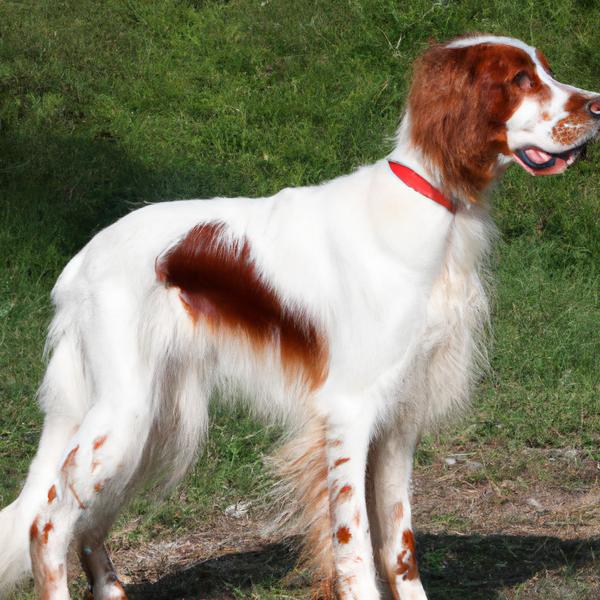Chesapeake Bay Retriever vs. Wirehaired Vizsla: Breed Differences and Similarities
Weight Gain Potential
Which breed eats more: Chesapeake Bay Retriever or Wirehaired Vizsla?
Chesapeake Bay Retriever has high obesity risk, needs regular exercise and food control to maintain healthy weight.
Wirehaired Vizsla has average risk of obesity, needs daily walks and quality diet to maintain healthy weight.
Hypoallergenic
Are Chesapeake Bay Retrievers or Wirehaired Vizslas hypoallergenic, or neither?
Unfortunately, neither Chesapeake Bay Retriever nor Wirehaired Vizsla are hypoallergenic, which may not make them the best choice for dog lovers who suffer from pet allergies.
Temperament
What are the personalities of Chesapeake Bay Retriever and Wirehaired Vizsla dogs?
Happy
Dominant
Protective
Affectionate
Intelligent
Quiet
Friendly
Intelligent
Going
Loving
Loyal
Protective
Shedding Level
Do Chesapeake Bay Retrievers shed more than Wirehaired Vizslas, or which breed sheds more, Chesapeake Bay Retrievers or Wirehaired Vizslas?
Chesapeake Bay Retrievers are moderate shedders, but regular brushing can reduce shedding and maintain coat health.
Wirehaired Vizslas shed very little hair, making them a great choice for those who dislike excess hair in the house.
Watchdog Ability
Which dog breed makes a better watchdog, the Chesapeake Bay Retriever or Wirehaired Vizsla?
Chesapeake Bay Retrievers are decent watchdogs - they'll alert their owner if something seems amiss.
Wirehaired Vizslas make excellent watchdogs - they're vocal and protective of their territory.
Origin
What is the origin of Chesapeake Bay Retriever and Wirehaired Vizsla dog breeds?
United States
Hungary
Ancestry
What are the origins of Chesapeake Bay Retriever and Wirehaired Vizsla breeds?
Newfoundland dog
turkish yellow dog, transylvania hound, weimaraner
Breed recognition
Which kennel clubs recognize/register Chesapeake Bay Retriever and Wirehaired Vizsla?
American Canine Registry
American Kennel Club
America's Pet Registry
Canadian Kennel Club
Dog Registry of America Inc.
Federation Cynologique Internationale
Kennel Club of Great Britain
North American Purebred Registry, Inc.
American Canine Association, Inc.
Australian National Kennel Council
Continental Kennel Club
National Kennel Club
New Zealand Kennel Club
United Kennel Club
American Canine Registry
American Kennel Club
America's Pet Registry
Canadian Kennel Club
Dog Registry of America Inc.
Federation Cynologique Internationale
North American Purebred Registry, Inc.
American Canine Association, Inc.
Continental Kennel Club
National Kennel Club
United Kennel Club
American Rare Breed Association
Date of Birth
When were Chesapeake Bay Retriever and Wirehaired Vizsla breeds first developed?
1800s
middle ages
Breed Group
What is the Breed Group of Chesapeake Bay Retriever and Wirehaired Vizsla?
Sporting (AKC:1878)
Gundog (UKC)
Sporting (AKC:2014)
Litter Size
What is the usual litter size for Chesapeake Bay Retriever and Wirehaired Vizsla?
A Chesapeake Bay Retriever can have a litter of 10-13 puppies on average. However, it's worth noting that the size of the litters can vary greatly. Factors that can influence litter size include the health of the mother, breeding history, and genetics.
A Wirehaired Vizsla can have a litter of 12-14 puppies on average. However, it's worth noting that the size of the litters can vary greatly. Factors that can influence litter size include the health of the mother, breeding history, and genetics.
Adaptability
Chesapeake Bay Retrievers have average adaptability to changes in lifestyle and living environments compared to other breeds.
Wirehaired Vizslas are highly adaptable and versatile, making them excellent companions for families and individuals of all lifestyles.
Health Issues
Between Chesapeake Bay Retriever and Wirehaired Vizsla, which breed is more prone to health problems?
Chesapeake Bay Retriever and Wirehaired Vizsla breeds are generally considered to be healthy. However, like all breeds, they are susceptible to certain health issues and it is important to keep an eye out for them and address them with your veterinarian as needed.
Major Concerns
What are the major health concerns for Chesapeake Bay Retriever and Wirehaired Vizsla breeds?
Hip Dysplasia
Usually A Very Healthy Breed
Minor Concerns
What minor health issues should be kept in mind when owning Chesapeake Bay Retriever and Wirehaired Vizsla?
Progressive Retinal Atrophy
Cataracts
Hip Dysplasia
Hemophilia A
Occasional Tests
What occasional tests are recommended for Chesapeake Bay Retriever and Wirehaired Vizsla breeds?
Eye
Hip
Blood
Dna For Vwd
Physical Examination
Blood
Blood Test
Hips
X-Rays
Energy
How do the energy levels of Chesapeake Bay Retrievers and Wirehaired Vizslas compare?
Chesapeake Bay Retriever and Wirehaired Vizsla breeds are high-energy dogs, thus an active lifestyle suits them well.
Social Needs
Chesapeake Bay Retriever vs Wirehaired Vizsla social needs comparison
Chesapeake Bay Retriever has average social needs and is less independent than other breeds.
Wirehaired Vizsla has below average social needs and is content with spending time alone.
Exercise Needed
Chesapeake Bay Retriever vs Wirehaired Vizsla exercise need comparison.
Chesapeake Bay Retrievers need high physical activity and are ideal for active individuals, but not suitable for sedentary lifestyles or small apartments.
Wirehaired Vizslas require significant physical activity and suit those with an active lifestyle.
Sleeping Need
Which of the two sleeps the most/least: Chesapeake Bay Retriever or Wirehaired Vizsla?
Chesapeake Bay Retriever and Wirehaired Vizsla are active dogs that may not require as much sleep as other breeds. However, they still need enough sleep to stay healthy.
Drooling Tendency
Which drools more/less, Chesapeake Bay Retriever or Wirehaired Vizsla?
Chesapeake Bay Retriever is an average drooler, monitor for excessive drooling which may indicate health issues.
Wirehaired Vizsla minimally drools, ideal for those who dislike drool marks on clothing.
Tendency to Bark
Do Chesapeake Bay Retrievers or Wirehaired Vizslas bark more/less frequently?
Chesapeake Bay Retrievers bark moderately when necessary and may also bark due to certain triggers like fear, alarm, boredom, greeting, separation anxiety and compulsive barking.
Wirehaired Vizslas are typically quiet and only bark when needed, such as to alert their owner or when in distress.
Territorial
Is the Chesapeake Bay Retriever or Wirehaired Vizsla a better guard dog?
While Chesapeake Bay Retriever dogs can defend their territory or owners, it's not their primary trait, and they are not ideal guard dogs.
Wirehaired Vizsla dogs have a strong protective nature and territorial instinct. They are highly vigilant and will fiercely defend their home and family.
Mouthiness
Mouthiness Comparison: Chesapeake Bay Retriever vs Wirehaired Vizsla?
Roaming urge
Chesapeake Bay Retriever vs Labrador: Running away tendency?
Prey Drive
Chesapeake Bay Retriever or Wirehaired Vizsla - which breed has a higher level of prey drive?
Tolerance of being left alone
Grooming
Which breed is easier to maintain in terms of grooming, Chesapeake Bay Retrievers or Wirehaired Vizslas?
Chesapeake Bay Retriever and Wirehaired Vizsla are breeds of dogs that are known for their low grooming needs.
Intelligence
Comparing Intelligence: Chesapeake Bay Retrievers vs Wirehaired Vizslas
Chesapeake Bay Retriever is a very intelligent and trainable breed.
Wirehaired Vizsla has below average obedience intelligence, but they excel in understanding human emotions.
Sensitivity Level
How do Chesapeake Bay Retriever and Wirehaired Vizsla compare in sensitivity?
Chesapeake Bay Retrievers have average emotions and adapt well to different situations.
This breed is sensitive to its environment and best suited for patient and understanding families with a consistent routine.
Affection Dependance
Which is the more affectionate dog breed: Chesapeake Bay Retriever vs Wirehaired Vizsla?
Apartment Friendly
Which breed is more apartment-friendly: Chesapeake Bay Retriever or Wirehaired Vizsla?
The Chesapeake Bay Retriever is not suitable for apartments and requires a large yard to thrive. Pent-up energy in small spaces can lead to destructive behavior.
Wirehaired Vizslas can do well in apartments with enough exercise and time outside, but a small yard would be ideal.
Child Friendly
Do Chesapeake Bay Retrievers or Wirehaired Vizslas have a friendlier temperament towards children?
Chesapeake Bay Retriever and Wirehaired Vizsla are kid-friendly dogs. They are good with children and excellent dogs with children if they are socialized and trained at a young age.
Senior-friendly
Which dog is more suitable as a pet for the elderly - Chesapeake Bay Retriever or Wirehaired Vizsla?
Cat Friendly
Do Chesapeake Bay Retriever or Wirehaired Vizsla breeds have a better compatibility with cats?
Chesapeake Bay Retrievers and Wirehaired Vizslas are an average cat friendly dog. They do well with cats, even more if raised together from puppyhood.
Dog Friendly
Which breed is more sociable with other dogs: Chesapeake Bay Retriever or Wirehaired Vizsla?
Chesapeake Bay Retrievers are less friendly towards other dogs, but can improve with socialization.
Wirehaired Vizslas are friendly and active companions, and can be good family pets, though their friendliness towards other dogs may vary.
Pet friendly
How do Chesapeake Bay Retriever or Wirehaired Vizsla dogs interact with other pets?
Stranger Friendly
Which breed is more friendly with strangers: Chesapeake Bay Retriever or Wirehaired Vizsla?
Chesapeake Bay Retrievers are quick to announce strangers and can be standoffish or suspicious.
Wirehaired Vizslas are friendly but may bark at strangers, and training is easy due to their intelligence.
Playfulness
Which breed is more playful between Chesapeake Bay Retriever and Wirehaired Vizsla?
Chesapeake Bay Retriever and Wirehaired Vizsla are playful dogs. So, no matter how busy the day may get, the best thing you can do for Chesapeake Bay Retriever and Wirehaired Vizsla is to make time each day to play. It can be as little as 15-20 minutes, and it will mean the world to them.
Trainability
How do the trainability levels of Chesapeake Bay Retrievers and Wirehaired Vizslas compare?
Chesapeake Bay Retrievers are usually easy to train but require consistency to fully obey commands.
Wirehaired Vizslas are popular for their ease of training and quick learning ability.
Compare Chesapeake Bay Retriever with other breeds

Greyhound
Chesapeake Bay Retriever vs Greyhound

Xoloitzcuintle
Chesapeake Bay Retriever vs Xoloitzcuintle

Irish Mastiff
Chesapeake Bay Retriever vs Irish Mastiff

Maremma Sheepdog
Chesapeake Bay Retriever vs Maremma Sheepdog

Sheltidoodle
Chesapeake Bay Retriever vs Sheltidoodle

Irish Red and White Setter
Chesapeake Bay Retriever vs Irish Red and White Setter

Chin Crested
Chesapeake Bay Retriever vs Chin Crested

Dusky
Chesapeake Bay Retriever vs Dusky

Wirehaired Vizsla
Chesapeake Bay Retriever vs Wirehaired Vizsla

Siberian Husky
Chesapeake Bay Retriever vs Siberian Husky

Rott Pei
Chesapeake Bay Retriever vs Rott Pei

Shelestie
Chesapeake Bay Retriever vs Shelestie
